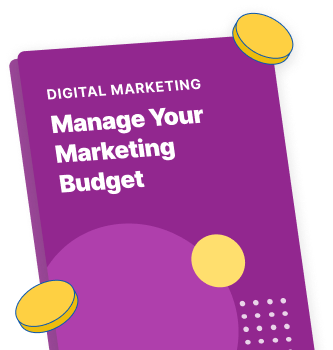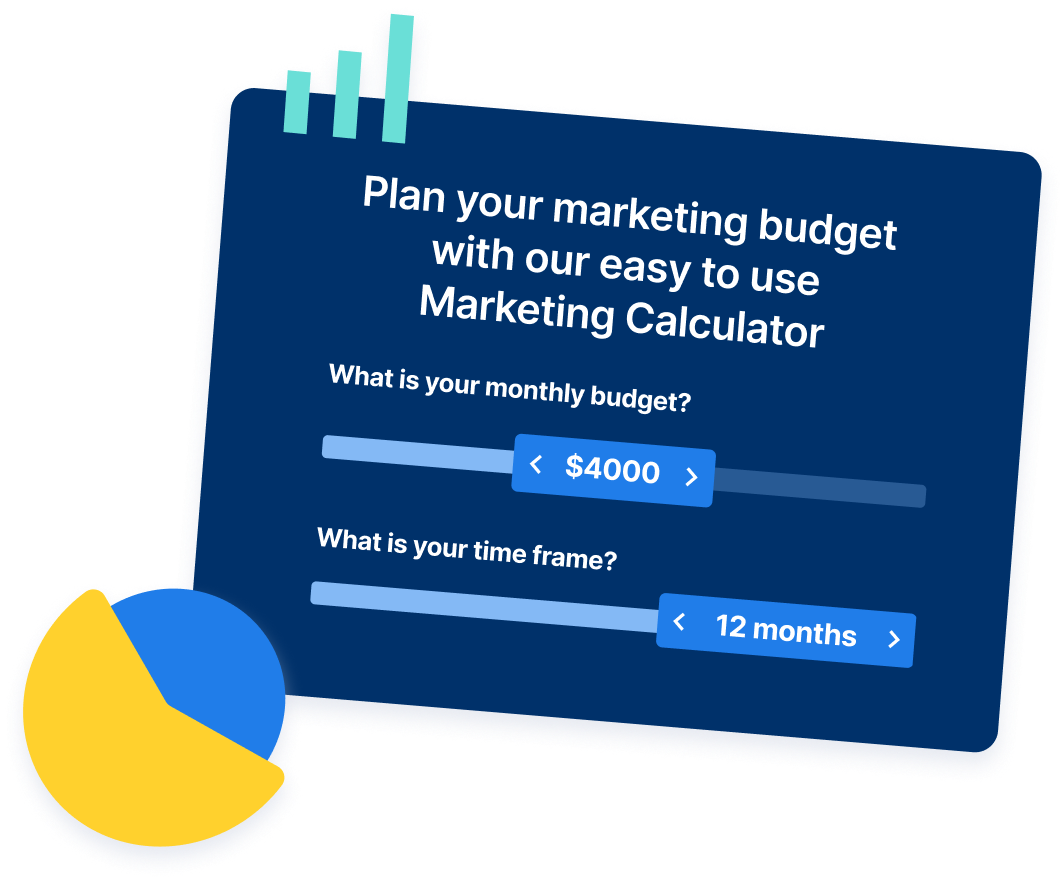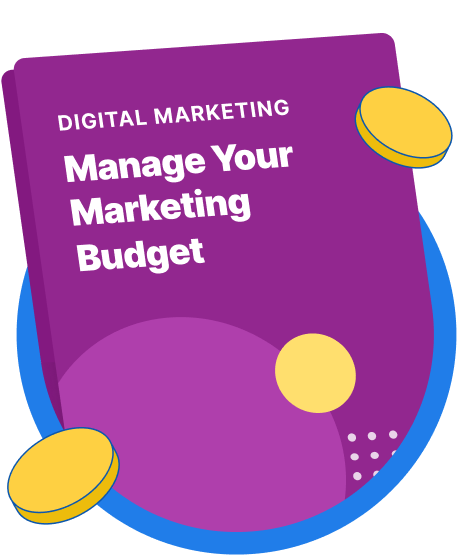-
 15 min. read
15 min. read
-
 Macy Storm
Macy Storm Senior Content Creator
Senior Content Creator
- Macy is a marketing writer with over five years of experience creating content for dozens of industries including food and beverage, home services, and education. She also specializes in creating SEO and PPC content. Her work has been featured by Search Engine Journal, HubSpot, Entrepreneur, Clutch, and more. In her free time, Macy enjoys trying new crafts and reading comic books.
As you prepare your business financially for 2024, you’ll want to evaluate your digital marketing budget. Digital marketing is becoming more important each year as the Internet and access to Internet-enabled devices grows.
To start your year off right, you’ll need to solidify your online marketing budget for this year. In this post, we’ll help you figure out how to allocate your budget and discuss website digital marketing strategies you’ll want to put your digital marketing budget toward.
P.S. Unlock more info about managing your marketing budget by downloading our free budgeting guide!
Are You Spending Your Marketing Budget Wisely?
Download our guide to learn how to plan your budget, set goals, track performance, and more!
Get My Free Guide
Quick Links
How do I set my digital marketing budget?
As you enter 2024, you’ll want to solidify your digital marketing budget for the year. If you’ve never set a digital marketing budget or haven’t seen positive results in the past, you can start this year off right by following some general rules.
Overall, most companies spend between 7-10% of their overall company revenue on marketing. This is a general rule of thumb that you can follow to ensure that you’re spending enough but not too much.
Of this 7-10% you’re allocating, about half or more of that should go toward digital marketing.
Many companies fall short of this benchmark, spending only a third of their marketing budgets on digital strategies.
However, with the growing popularity of the Internet, it’s crucial that you allocate enough money to advertise your business online.
There are thousands of leads looking for your business online and if you don’t put enough money into your campaign, you’ll miss out on valuable leads and revenue.
Each year, digital marketing becomes more and more important. As technology continues to evolve, you’ll want to put more money into digital marketing efforts than your traditional marketing efforts.
The 70-20-10 rule
When you’re setting up your digital marketing budget, the 70-20-10 rule is extremely helpful for helping you allocate funds effectively. Here’s how that breaks down.
Spend 70% of time and money on “now”
With this rule, you should spend 70% of your time and digital marketing budget for 2024 on the “now.” The “now” consists of strategies you know work well for your business.
Whether it’s a digital marketing strategy or a product or service that drives valuable revenue for your business, focus on spending your money toward helping those aspects drive even better results for your business.
This is a safe place to allocate your budget because you already know that these strategies, products, and services work for your business.
You can use the money to optimize your performance to drive valuable results.
Spend 20% of time and money on “next”
Twenty percent of your budget should go toward things that are on the horizon.
These are strategies that are new to your business.
For instance, you might introduce and market a new product line or service or target new segments to expand your market share. Putting money toward the “next” helps your business grow.
You move your business forward by investing in different products and marketing methods that help you reach new leads and earn more conversions.
Spend 10% of time and money on “new”
A small portion of your digital marketing budget should go toward the “new.”
These are the unknowns of the digital marketing world, like emerging technology or experimental strategies. To give your business the opportunity to stay ahead of the competition, you must invest some of your budget into new ideas.
This can be anything from up-and-coming technology to testing new ideas.
You want to put money toward experimental ideas to see if they will pay off for your business.
The 70-20-10 rule isn’t set in stone. It’s a good starting point, but you don’t need to follow it precisely. For the 10% on “new”, that may be too much for businesses with bigger budgets.
You can always adjust the ratio to fit your business and your goals.
We foster and form long-term partnerships so that your business has long-term results.
Over 90% of WebFX clients continue partnering with us into year 2 of their campaign.
Hear from Our Happy Customers

5 places to invest your online marketing budget
As you start to set up your digital marketing budget for 2024, you must consider what methods you will use.
Here are five digital marketing methods to consider using in your budget:
- Search engine optimization (SEO)
- Pay-per-click (PPC) advertising
- Email marketing
- Ecommerce marketing
- Marketing automation
1. SEO
Search engine optimization (SEO) is a great method to budget for in 2024. This is the process of boosting your website’s ranking in the search results. SEO helps you reach valuable traffic that is interested in your products or services.
Optimizing for now
Optimize SEO now by optimizing your SEO campaign with trusted techniques.
For example:
- Target keywords in your title tags
- Produce SEO-friendly content for your website
- Built high-quality backlinks to your site
- Optimize image file sizes
- Use responsive design to support all devices
You’ll also want to prioritize page speed, especially with Google’s Core Web Vitals update.
This update looks at how your website loads for users. For example, Google uses First Input Delay to measure how long it takes for your site to become interactive for users — or how long someone has to wait before they can take an action on your site, like clicking a button.
Like past Google algorithm updates, the Core Web Vitals update emphasizes Google’s continued focus on delivering search results that not only meet someone’s search intent but also meet someone’s expectations for a fast, no-fuss search experience.
If you haven’t looked at how your site performs against this update, try SERP Racer. This free tool will show your website’s Core Web Vitals — and compare them against the competition.
Type in a keyword that matters to your business and see how your site performs against your competitors.
Then, get to work on improving your Core Web Vitals so you can capture more search traffic.
P.S. If you need help mastering Core Web Vitals, check out our page speed optimization plans!
Optimizing for next
Voice search continues to gain SEO momentum. Voice search devices, like Google Home and Amazon Echo, make their way into more homes each day.
People are using these devices to conduct searches and find important information. If you want to optimize for the next new thing, start optimizing for voice search.
This technology is rising in popularity, so you’ll want to adapt your SEO campaign to fit voice search.
This includes optimizing for slang words, providing quick and informative answers, and making your information easy to be spoken.
Optimizing for new
Google is constantly looking for new ways to optimize its search results. The goal is always to get the user to be able to find what they need.
When you invest in SEO, you’ll need to keep up with new experimental ways of searching. An example of a type of search style is photo search.
This is growing as a popular way to conduct searches.
People can upload images or take a photo to learn information about that object. Just check out Google Lens to see what Google can do.
This is a revolutionary way of searching. While photo search isn’t a prominent way to search, it’s gaining traction.
For example, someone looking to buy a piece of clothing from a Pinterest post might use photo search to track down the company.
Even in the business-to-business (B2B) sector, a user might rely on their phone’s camera — using Google Lens — to identify and replace an older part. Google’s use of 3D and augmented reality in search results even offers the B2B industry a way to preview and see large components up close.
If you want to experiment with photo search SEO, optimize your alt text and image descriptions.
2. PPC advertising
Pay-per-click (PPC) advertising is a great strategy to help your business reach more qualified leads.
This paid form of advertising allows you to reach valuable leads that are interested in your products or services. These ads appear at the top of the search results, above the organic listings.
When you work with the right PPC ad company, PPC ads help you earn valuable leads that are interested in your business. In fact, 65% of all high-intent searches result in someone clicking on a PPC ad.
These ads are extremely valuable for helping your business obtain leads that want your products or services.
Optimizing for now
The best way to optimize for now is by conducting keyword research.
Keyword research will help you find the right keywords for your PPC campaign. Considering keywords trigger your website to appear in the search results, you’ll want to optimize your keyword strategy to ensure you’re driving the best results.
Optimizing for next
Google isn’t the only company that offers PPC ad options. Amazon and Facebook also started offering PPC ad options for your business.
In the future, Apple may play a role in promoting PPC ads. To optimize for the next, optimize for platforms outside of Google. Even though Google is the most popular place for PPC ads, other platforms are rising in popularity as viable sources for PPC ads.
Optimizing for new
As search strategies continue to evolve, there are opportunities for new ways for users to find products or services.
There is a possibility that some people could simply scan a product and generate search results based on the product’s UPC code. You may need to consider adapting your PPC ads to fit these types of unique search strategies in the future.
3. Email marketing
Email marketing is one of the most valuable methods your business can invest in this year.
This method allows you to connect directly with leads that want to hear from your business. You’ll want to allocate funds toward this method because it’ll drive valuable results.
When you obtain subscribers, you do it organically by placing email sign-up forms on your website. This means you’ll only attract people that want to hear from your business.
With email marketing, you can send specific messages to people to get them interested in your products.
Email marketing allows you to segment your audience to send them tailored content reflective of their needs. This is a great method to help nurture leads toward conversion.
As you set your digital marketing budget for this year and maybe the next one, allocate money to boost your email marketing efforts.
Optimizing for now
Email marketing is an effective strategy for nurturing leads and earning more conversions.
To optimize your email marketing strategy, for now, the best thing you can do is segment your audience. Audience segmentation is a valuable resource for helping your business drive better results.
You’ll want to segment your audience by demographic information and interests.
Group people together based on their interests and the types of products or services they want to see from your business. It helps you drive a more effective campaign because the content is tailored to their likes and needs.
Optimizing for next
Since more than 50% of people in the U.S. use an iPhone, you can’t ignore Apple’s announcement on email tracking pixels.
The company’s update, called Mail Privacy Protection, will allow users to load email content privately, which means businesses won’t have an accurate measurement for open rates.
If you use open rates to measure the success of your email marketing strategy, you’ll need to pivot. Instead, focus on metrics that impact your business and its bottom line.
For example, how many online transactions have your email campaign for abandoned shopping carts generated?
In this example, online transactions — versus opens — are what really matter to your business.
Optimizing for new
Once you have an established strategy for generating subscribers, think about personalization. With so many companies competing for the same person’s attention, personalization rises as a driving factor for choosing a business.
People want to feel valued by companies and personalization is a key component to feeling valued.
The biggest rising trend is creating 1:1 emails that are specific to each individual subscriber. Think of in terms of how Netflix suggests shows based on a user’s individual interests and viewing behavior.
These emails would focus specifically on how a user shops and provide them with the best products for their shopping behavior.
4. Ecommerce marketing
Ecommerce played an all-star role last year, and continues to have star power.
As a digital marketing channel, ecommerce shows no signs of slowing down, which is why it’s a great place to think about investing your online marketing budget.
Optimizing for now
If you want to get started with ecommerce marketing now, think about:
- Researching where you can sell online, like Amazon or Walmart
- Learning how to sell on an online marketplace
- Launching on an online marketplace
Companies new to online selling should think about selling on Amazon first.
Amazon is an established online marketplace. Besides offering access to your target audience, Amazon also provides logistics solutions so you can skip processing orders, returns, and more.
Optimizing for next
Your business can embrace ecommerce marketing on its site, too.
Selling on your website can take some time and some investment, as you’ll need to set up product pages and payment processing, but it’s a worthwhile investment. For example, with an ecommerce store on your site, you can skip the seller fees on places like Amazon.
Besides creating an online store, you’ll also want to work on driving traffic to your website with strategies like SEO and PPC.
With a growing traffic source, your business can generate revenue from its store — and even re-invest some of those earnings into upgrading your site.
Optimizing for new
Is your business seasoned when it comes to selling online?
Then, think about investing your digital marketing budget into some of the other strategies on this list for boosting your ecommerce performance. For example:
- Use photo SEO to bring more traffic and ready-to-buy users to your site
- Upgrade your email strategy to build automated journeys that convert at a higher rate
- Invest in marketing automation software to streamline ROI tracking
- Launch Google Shopping ads to attract bottom-of-the-funnel traffic
You can also re-invest in your website and implement updates that improve:
- Page speed
- Conversion rates
- User experience
- And more
If you don’t have the time for these projects in-house, you can always hire a web design agency.
5. Marketing automation
Marketing automation is one of the best places to invest your digital marketing budget.
That’s because marketing automation can benefit every strategy in your online marketing plan, from search to social to email. Whether you’re looking to create automated email journeys or improve your return on investment (ROI) measuring, marketing automation can help.
Optimizing for now
When it comes to now, you can spend your marketing automation budget on a few smart tools:
- Google Optimize: With Google Optimize, you can start, streamline, and scale conversion rate optimization (CRO). This free tool makes setting up, monitoring, and analyzing A/B tests easy. Even better, you can use Google Optimize to create and launch personalizations.
- MarketingCloudFX: You can’t ignore digital marketing ROI in 2024 — or 2024. That’s why marketing automation software like MarketingCloudFX is so valuable. With MarketingCloudFX, you can measure ROI across all your marketing channels instantly and track user journeys.
If you already use marketing automation in your business, skip to the next section for more ideas!
Optimizing for next
Other areas where your digital marketing budget could level up your marketing automation include:
- Google Analytics 4: Your business can have the best of both worlds when it comes to Google Analytics. Besides using Universal Analytics, your company can try Google Analytics 4, which uses your website data to provide you with more insight into your buyer’s journey.
- Nutshell: Help your business close more sales with a customer relationship management (CRM) solution that syncs marketing and sales data. With a platform like Nutshell, your sales team gets the tools they need.
- EmailMarketingFX: Email is one of the best examples of marketing automation. If you haven’t experimented with email marketing automation, give it a go with EmailMarketingFX, which offers small-to-midsized businesses a cost-effective solution over other platforms.
Looking for more places to invest your marketing automation budget? Check out the next section!
Optimizing for new
Companies with an established marketing automation strategy should think about marketing automation software that provides solutions for an online world free of cookies.
For example, tools like Segment and Lusha will help your business gather user data from existing website traffic.
However, it’s important to note that your company will get the most value from these tools if you have high traffic numbers.
If your business’s website doesn’t pull in enough traffic, you’ll struggle to get enough user data to generate an ROI from your investment in these tools.
Start budgeting for 2024 today
As you prep your marketing for the new year, it’s crucial that you start organizing your budget to know where to put your money. Have questions about any of the strategies discussed in this post?
Need to know how to get more marketing budget or want to ensure your budget goes to the channels that will drive the most revenue?
Feel free to contact us online today to speak with a strategist!
-
 Macy is a marketing writer with over five years of experience creating content for dozens of industries including food and beverage, home services, and education. She also specializes in creating SEO and PPC content. Her work has been featured by Search Engine Journal, HubSpot, Entrepreneur, Clutch, and more. In her free time, Macy enjoys trying new crafts and reading comic books.
Macy is a marketing writer with over five years of experience creating content for dozens of industries including food and beverage, home services, and education. She also specializes in creating SEO and PPC content. Her work has been featured by Search Engine Journal, HubSpot, Entrepreneur, Clutch, and more. In her free time, Macy enjoys trying new crafts and reading comic books. -

WebFX is a full-service marketing agency with 1,100+ client reviews and a 4.9-star rating on Clutch! Find out how our expert team and revenue-accelerating tech can drive results for you! Learn more
Try our free Marketing Calculator
Craft a tailored online marketing strategy! Utilize our free Internet marketing calculator for a custom plan based on your location, reach, timeframe, and budget.
Plan Your Marketing Budget

Maximize Your Marketing ROI
Claim your free eBook packed with proven strategies to boost your marketing efforts.
Get the GuideTry our free Marketing Calculator
Craft a tailored online marketing strategy! Utilize our free Internet marketing calculator for a custom plan based on your location, reach, timeframe, and budget.
Plan Your Marketing Budget





